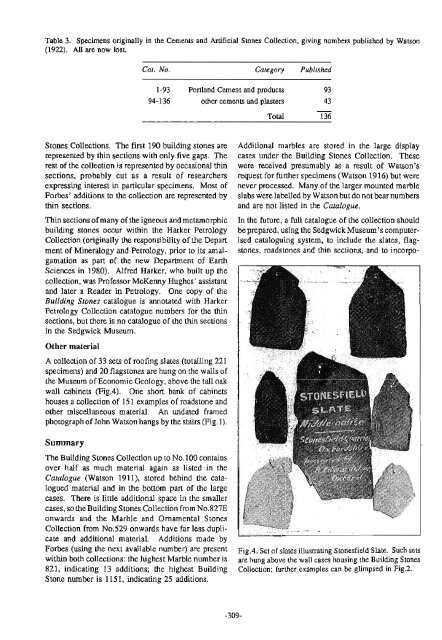Number 8 - Geological Curators Group
Number 8 - Geological Curators Group
Number 8 - Geological Curators Group
- No tags were found...
You also want an ePaper? Increase the reach of your titles
YUMPU automatically turns print PDFs into web optimized ePapers that Google loves.
Table 3. Specimens originally in the Cements and Artificial Stones Collection, giving numbers published by Watson(1922). All are now lost.Cat. No. Category Published1-93 Portland Cement and products 9394-136 other cements and plasters 43Total 136Stones Collections. The first 190 building stones arerepresented by thin sections with only five gaps. Therest of the collection is represented by occasional thinsections, probably cut as a result of researchersexpressing interest in particular specimens. Most ofForbes' additions to the collection are represented bythin sections.Thin sections of many of the igneous and metamorphicbuilding stones occur within the Harker PetrologyCollection (originally the responsibility of the Department of Mineralogy and Petrology, prior to its amalgamationas part of the new Department of EarthSciences in 1980). Alfred Harker, who built up thecollection, was Professor McKenny Hughes' assistantand later a Reader in Petrology. One copy of theBuilding Stones catalogue is annotated with HarkerPetrology Collection catalogue numbers for the thinsections, but there is no catalogue of the thin sectionsin the Sedgwick Museum.Other materialA collection of 33 sets of roofing slates (totalling 221specimens) and 20 flagstones are hung on the walls ofthe Museum of Economic Geology, above the tall oakwall cabinets (Fig.4). One short bank of cabinetshouses a collection of 151 examples of roadstone andother miscellaneous material. An undated framedphotograph of John Watson hangs by the stairs (Fig. 1).SummaryThe Building Stones Collection up to No.100 containsover half as much material again as listed in theCatalogue (Watson 1911), stored behind the cataloguedmaterial and in the bottom part of the largecases. There is little additional space in the smallercases, so the Building Stones Collection from No.827Eonwards and the Marble and Ornamental StonesCollection from No.529 onwards have far less duplicateand additional material. Additions made byForbes (using the next available number) are presentwithin both collections: the highest Marble number is821, indicating 13 additions; the highest BuildingStone number is 1151, indicating 25 additions.Additional marbles are stored in the large displaycases under the Building Stones Collection. Thesewere received presumably as a result of Watson'srequest for further specimens (Watson 1916) but werenever processed. Many of the larger mounted marbleslabs were labelled by Watson hut do not bearnumbersand are not listed in the Catalogue.In the future, a full catalogue of the collection shouldbe prepared, using the Sedgwick Museum's computerisedcataloguing system, to include the slates, flagstones,roadstones and thin sections, and to incorpo-Fig.4. Set of slates illustrating Stonesfield Slate. Such setsare hung above the wall cases housing the Building StonesCollection; further examples can be glimpsed in Fig.2.
















